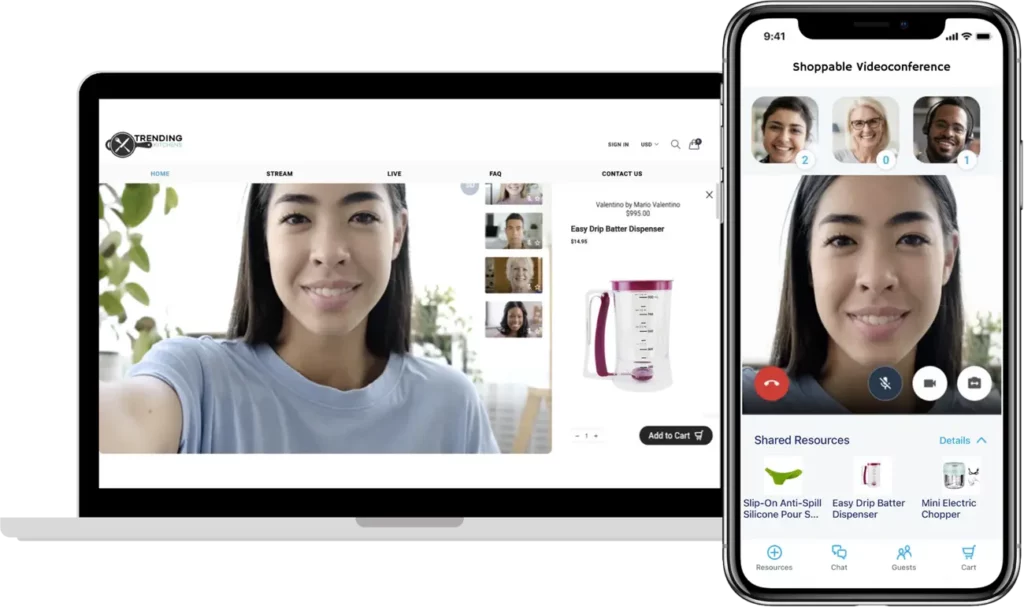The next evolution of ecommerce is here!
Ecommerce has gone through three decades of evolution and significant growth despite original fears that a lack of human presence and social interaction would discourage online shopping. Despite the growth, ecommerce still accounts for less than 20% of global retail sales. Conversion rates of conventional ecommerce and of social media selling hover in the low to mid, single digits.
With in-person conversion rates that are five to ten times greater than online rates, the key to ecommerce success is to increase trust and warmth in online transactions.
Enter Livestream Shopping – ecommerce’s next evolution!
First, let’s define the term “livestreaming.” Livestreaming is a generic term that refers to the streaming of live, digital video content and includes two types of services: (1) online videoconferencing like Zoom, Teams, Google Meets (2) livestreaming services on platforms like Facebook, Instagram, and YouTube. Livestream shopping simply adds purchasing features to a livestream experience allowing livestream participants to purchase products during the livestream event.
The best way to understand the difference between shoppable livestreaming and shoppable videoconferencing is to think of shoppable livestreaming as a “stadium” and shoppable videoconferencing as an intimate, backyard concert. Shoppable livestreaming allows the presenter to speak to large audiences with communication largely being one-way and participants limited to providing input through chat and emojis. On the other hand, shoppable videoconferencing enables presenters and participants to interact with each other while the presenter share products to the screen. In both cases, participants can add products directly to their carts during the livestream shopping event.
Which one is best for direct selling?
Direct Selling was founded on the idea of personalized selling. Additionally, direct sellers have expanded their markets beyond their immediate neighborhoods and cities to include other states and countries. Direct sellers have turned to online product and opportunity meetings to connect and grow their organizations and to increase their available selling time. In person events and meetings will always be part of direct selling’s DNA but having the ability to conduct shoppable videoconferences will allow direct sellers to conduct more meetings, to interact better with their growing organizations and to be better prepared to face challenges like COVID.
Shoppable videoconferencing is a natural next step for today’s direct sellers. They can continue to conduct in person events but can complement those efforts with virtual, shoppable videoconferences that can be conducted in greater numbers and that can be more easily incorporated into their busy lives. However, it would be inaccurate to say that shoppable livestreaming (stadium) has no place in direct selling. For example, top leaders could leverage shoppable livestreaming to reach their large organizations and announce special sales, new products, or events. This works best for top leaders because they have large organizations from which to draw an audience, and because such events don’t necessitate the individual attention of a shoppable videoconference. Additionally, by leveraging shoppable videoconferencing and livestreaming, direct selling companies can finally quantify the number and success of online selling events.

Regardless, there’s no denying that empowering direct sellers to conduct shoppable videoconferences or shoppable livestreams directly from their distributor sites is consistent with what has made direct selling such a successful distribution channel for many great brands. And by seamlessly integrating livestream shopping directly with distributor sites, direct selling companies don’t have to worry about managing and maintaining multiple ecommerce platforms. What’s more and as is customary with today’s videoconferencing and livestreaming services, participants join livestream events through their browsers. In fact, today’s shoppable videoconferencing and livestreaming services have broad appeal across all generations because the technology is the perfect combination of ecommerce and social media but incredibly easy to use with high adoption rates.
Final Thoughts
The line between online and IRL (In Real Life) selling is quickly disappearing, and the successful online retailers of tomorrow will be those that can architect a consistent, omnichannel experience that allows sellers and consumers to traverse the online and IRL selling experience with little to no friction. And because some of these platforms can be implemented in a matter of days, not months, and a select few can also leverage an organization’s existing web sites and ecommerce platforms, time to market is fast while providing high adoption and conversion rates. This is critical considering that it is estimated that the cost of unused or rarely used technology in the United States is over $30 billion per year. What’s more, companies embracing the next evolution of ecommerce are experiencing online conversion rates that are five to ten times greater than conventional ecommerce and social media selling; rates that are finally comparable to those of in person selling – embrace the “evolution!”